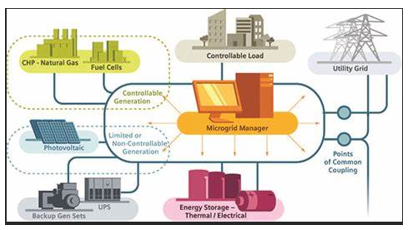The combination of increasingly cost-effective distributed generation, environmental motivations and the 24/7 digital economy has given rise to the deployment of Microgrids. These small clusters of energy assets and loads can be controlled to achieve a variety of benefits for the operator. The result is increased reliability during grid system disturbances such as storm outages.
RTOs like MISO and PJM as well as our local utilities work with industry partners, universities and states to better understand how Microgrids operate, how they can impact the grid in a positive way and how they can access wholesale market services. To get a better understanding, let’s start with some basic information:
What is a Microgrid?
A Microgrid is a local energy grid with control capability, which means it can disconnect from the traditional grid and operate autonomously.
How does a Microgrid work?
To understand how a Microgrid works, you first have to understand how the grid works.
 The grid connects homes, businesses and other buildings to central power sources, which allow us to use appliances, heating/cooling systems and electronics. But this interconnectedness means that when part of the grid needs to be repaired, everyone is affected.
The grid connects homes, businesses and other buildings to central power sources, which allow us to use appliances, heating/cooling systems and electronics. But this interconnectedness means that when part of the grid needs to be repaired, everyone is affected.
This is where a Microgrid can help. A Microgrid generally operates while connected to the grid, but importantly, it can break off and operate on its own using local energy generation in times of crisis like storms or power outages, or for other reasons.
A Microgrid can be powered by distributed generators, batteries, and/or renewable resources like solar panels. Depending on how it’s fueled and how its requirements are managed, a Microgrid might run indefinitely.
How does a Microgrid connect to the grid?
A Microgrid connects to the grid at a point of common coupling that maintains voltage at the same level as the main grid unless there is some sort of problem on the grid or other reason to disconnect. A switch can separate the Microgrid from the main grid automatically or manually, and it then functions as an island.
Why would a community choose to connect to Microgrids?
A Microgrid not only provides backup for the grid in case of emergencies, but can also be used to cut costs, or connect to a local resource that is too small or unreliable for traditional grid use. A Microgrid allows communities to be more energy independent and, in some cases, more environmentally friendly.
How much can a Microgrid power?
A Microgrid comes in a variety of designs and sizes. A Microgrid can power a single facility like the Santa Rita Jail Microgrid in Dublin, California. Or a Microgrid can power a larger area. For example, in Fort Collins, Colorado, a Microgrid is part of a larger goal to create an entire district that produces the same amount of energy it consumes.
To learn more about Microgrids, you can visit the U.S. Department of Energy’s Office of Electricity’s Microgrid activities page.
